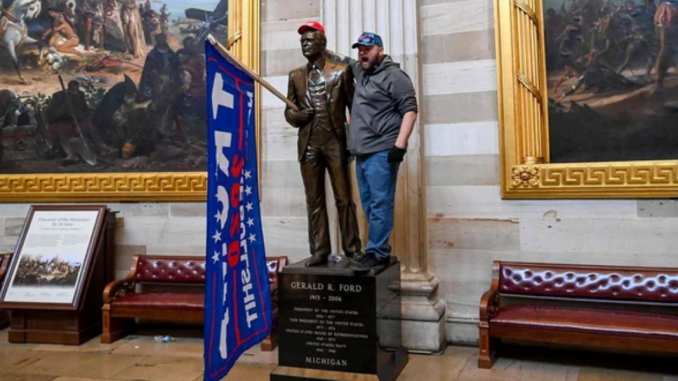
They posted that they were storming the Capitol to Facebook. They livestreamed it on YouTube and made Instagram stories of their fellow rioters as they broke in.
As the FBI continues to round up rioters who stormed the U.S. Capitol on Jan. 6 to try to stop President-elect Joe Biden’s inauguration last week, it’s finding that a number of them seem to have openly confessed to crimes on open social media, a review of court documents shows.
Capitol Police have been resoundingly criticized for being unprepared to deal with the number of rioters who overwhelmed them and broke into the halls of Congress, leaving the FBI to track down many of them after they left the scene.
But while federal law enforcement has significant legal and technical resources at its disposal — like the ability to get warrants to phone or tech companies to see whose phones were in an area at a specific time, for instance — that’s proven unnecessary for a number of people who have been charged so far.
Many were documented by journalists, then easily identified online. Adam Johnson, charged with theft of government property after a Getty photograph of him smiling as he carried off Speaker of the House Nancy Pelosi’s lectern went viral, also posted a photo of himself that day to his Facebook account. Wearing the same clothing and distinctive hat, in front of a sign that says “Closed to all tours,” Johnson captioned the photo “No.”
Derrick Evans, a self-proclaimed conservative activist who was recently elected to the West Virginia House of Delegates but resigned before his first session began, livestreamed himself yelling “Derrick Evans is in the Capitol!” Though Evans deleted the video, a local reporter had already recorded and soon tweeted it.
Selfies inside the Capitol were common, and a number of people who took them have been charged with knowingly entering restricted grounds or disorderly conduct on Capitol grounds.
Kash Lee Hill posted a photo, since removed, to his public Facebook account that shows him standing on a pedestal next to a statue of Charles Aycock, a former governor of North Carolina and white supremacist. The state has sought to replace the statue with one of the late televangelist Billy Graham. “The day we let the Traitors who constantly push the divide in OUR country know that we are done playing their games,” Hill’s caption read.
Thomas Robertson, an officer at the Rocky Mount Police Department in Virginia, Instagrammed a photo of himself with fellow officer Jacob Fracker in front of a marble statue. Fracker posted to Facebook that he was unapologetic for the photo.
“Lol to anyone who’s possibly concerned about the picture of me going around…. sorry I hate freedom?” After a shrugging emoji, Robertson wrote “not like I did anything illegal.”
Jenny Cudd, who wore a President Donald Trump flag as a cape into the Capitol, described on Facebook Live being part of a crowd that forced their way into the building.
“We just pushed, pushed, and pushed, and yelled go and yelled charge. We just pushed and pushed, and we got it,” Cudd said, later adding “We did break down the Nancy Pelosi’s office door.”
A small army of online sleuths are actively hunting through images from the Jan. 6 to identify rioters, and the FBI, which is still soliciting tips from the public, has received more than 126,000 digital media tips from the incident, an agency spokesperson said Thursday.
But that hasn’t been necessary for some suspects. Many showed up to the Capitol in costumes that made them easily recognizable. Jacob Chansley, indicted on six charges, stood out in photos with his American flag facepaint, bare torso, and horned fur headdress. He was already well known to researchers and journalists who cover extremism because that was his getup as the “QAnon Shaman” at Trump rallies and anti-Black Lives Matter protests.
Robert Packer shocked many Americans with his “Camp Auschwitz” black sweatshirt, but that wasn’t the first time he’d worn it. Court documents show that someone tied to a convenience store in Packer’s town of Newport News, Virginia, recognized him as a regular. The person gave the FBI photos from the store’s surveillance cameras of Packer previously wearing the same sweatshirt in the store, as well as of his car.
Olympic gold medalist swimmer Klete Keller, charged with knowingly entering or remaining on restricted grounds, wore his Team USA jacket to the Capitol.
Larry Brock, a decorated Air Force Combat veteran, was easily recognizable to those who knew him when wore his uniform, including medals and helmet, as he carried zip-tie handcuffs on the Senate floor.
“I just know that when I saw this was happening I was afraid he would be there,” Brock’s ex-wife said in a call to the FBI. “I think you already know he was there. It is such a good picture of him and I recognize his patch.”
Investigators have still used traditional warrants to seal their cases against the rioters, however. In one instance, a warrant for a suspected rioter’s social media account showed him seeming to confess. Aaron Mostofsky, the son of a Brooklyn judge who’s accused of stealing government property, became a meme as a photo of him wearing a stitched together fur costume and police vest went viral.
A friend messaged Mostofsky a version of the meme, captioned “Imagine coming off 10 hits of acid and U look around and ur in the US Capitol like shit,” to his Instagram account, @aaron_mostofsky_official.”
“Your famous,” the friend said.
“IK unfortunately,” Mostofsky replied.
*story by NBC News